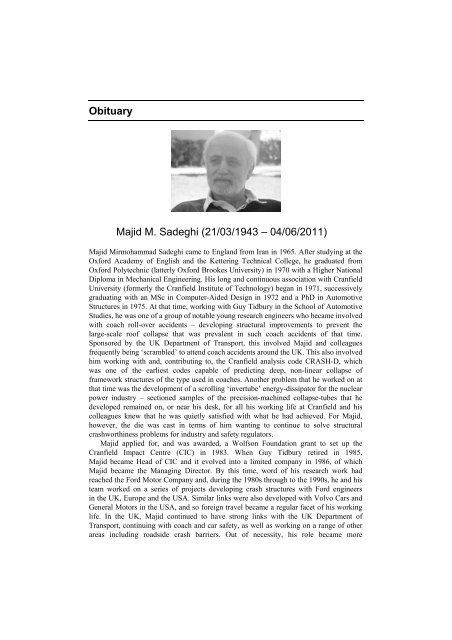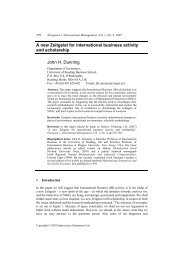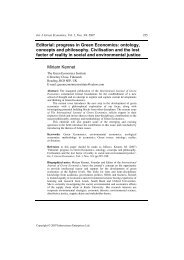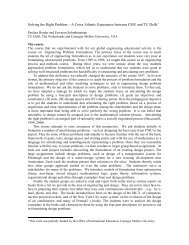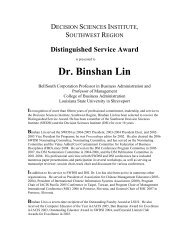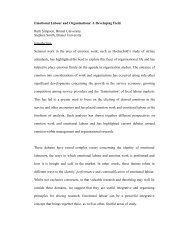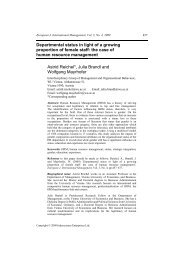Obituary Majid M. Sadeghi (21/03/1943 â 04/06/2011)
Obituary Majid M. Sadeghi (21/03/1943 â 04/06/2011)
Obituary Majid M. Sadeghi (21/03/1943 â 04/06/2011)
Create successful ePaper yourself
Turn your PDF publications into a flip-book with our unique Google optimized e-Paper software.
<strong>Obituary</strong><br />
<strong>Majid</strong> M. <strong>Sadeghi</strong> (<strong>21</strong>/<strong>03</strong>/<strong>1943</strong> – <strong>04</strong>/<strong>06</strong>/<strong>2011</strong>)<br />
<strong>Majid</strong> Mirmohammad <strong>Sadeghi</strong> came to England from Iran in 1965. After studying at the<br />
Oxford Academy of English and the Kettering Technical College, he graduated from<br />
Oxford Polytechnic (latterly Oxford Brookes University) in 1970 with a Higher National<br />
Diploma in Mechanical Engineering. His long and continuous association with Cranfield<br />
University (formerly the Cranfield Institute of Technology) began in 1971, successively<br />
graduating with an MSc in Computer-Aided Design in 1972 and a PhD in Automotive<br />
Structures in 1975. At that time, working with Guy Tidbury in the School of Automotive<br />
Studies, he was one of a group of notable young research engineers who became involved<br />
with coach roll-over accidents – developing structural improvements to prevent the<br />
large-scale roof collapse that was prevalent in such coach accidents of that time.<br />
Sponsored by the UK Department of Transport, this involved <strong>Majid</strong> and colleagues<br />
frequently being ‘scrambled’ to attend coach accidents around the UK. This also involved<br />
him working with and, contributing to, the Cranfield analysis code CRASH-D, which<br />
was one of the earliest codes capable of predicting deep, non-linear collapse of<br />
framework structures of the type used in coaches. Another problem that he worked on at<br />
that time was the development of a scrolling ‘invertube’ energy-dissipator for the nuclear<br />
power industry – sectioned samples of the precision-machined collapse-tubes that he<br />
developed remained on, or near his desk, for all his working life at Cranfield and his<br />
colleagues knew that he was quietly satisfied with what he had achieved. For <strong>Majid</strong>,<br />
however, the die was cast in terms of him wanting to continue to solve structural<br />
crashworthiness problems for industry and safety regulators.<br />
<strong>Majid</strong> applied for, and was awarded, a Wolfson Foundation grant to set up the<br />
Cranfield Impact Centre (CIC) in 1983. When Guy Tidbury retired in 1985,<br />
<strong>Majid</strong> became Head of CIC and it evolved into a limited company in 1986, of which<br />
<strong>Majid</strong> became the Managing Director. By this time, word of his research work had<br />
reached the Ford Motor Company and, during the 1980s through to the 1990s, he and his<br />
team worked on a series of projects developing crash structures with Ford engineers<br />
in the UK, Europe and the USA. Similar links were also developed with Volvo Cars and<br />
General Motors in the USA, and so foreign travel became a regular facet of his working<br />
life. In the UK, <strong>Majid</strong> continued to have strong links with the UK Department of<br />
Transport, continuing with coach and car safety, as well as working on a range of other<br />
areas including roadside crash barriers. Out of necessity, his role became more
managerial as the work of the group expanded but, as with all true engineers, he took<br />
great pride in keeping his finger on the technical pulse. His knowledge and sheer<br />
enthusiasm played a key role in developing the test facilities at CIC for motorsport crash<br />
testing, which has led to CIC becoming the first FIA-approved crash centre and<br />
remaining one of only three in the world.<br />
In 1989, <strong>Majid</strong>’s unceasing representation of the capabilities of his group resulted<br />
in CIC working for the UK Air Accidents Investigation Branch, using FEA techniques<br />
to reconstruct the air accident at Kegworth, UK, as part of the formal accident<br />
process; again a world first. This led to a series of other such involvements in the UK<br />
and internationally, including a series of projects with the US Federal Aviation<br />
Administration.<br />
During the 1990s, <strong>Majid</strong> was fundamental to CIC’s involvement with the UK<br />
Ministry of Defence in defining bone fracture loads and developing personnel protection<br />
equipment for aircrew under crash landing and ejection events. During this period,<br />
CIC also included a Micro Electronics group, who developed intelligent data-logging<br />
systems for crash and other applications, and he took great interest and pride in what was<br />
a new technical field to him. EC research projects were all part of <strong>Majid</strong>’s lexicon as he<br />
oversaw CIC’s participation in crashworthiness studies, ranging from road vehicles and<br />
pedestrians through to train and aircraft structures. During all this commercial activity,<br />
<strong>Majid</strong> ensured that CIC remained true to its academic roots by supporting the activities of<br />
Cranfield University in the field of crashworthiness and occupant survivability when<br />
asked to do so, and to the extent that CIC supported a number of its own PhD students<br />
over the years of his directorship. Prior to his retirement in 20<strong>03</strong>, it is fitting that one of<br />
his last projects was for the Iran Khodro Car Company, helping them to develop<br />
crashworthy structures.<br />
<strong>Majid</strong> sought during the remainder of his life to apply his expertise to prospective<br />
transportation projects in his native Iran, and also became one of the founding editors of<br />
the International Journal for Vehicle Safety in 2005. He discovered anew his talent for<br />
imparting knowledge to people of all ages by volunteering to teach children at a local<br />
school. A few weeks before his sad death, <strong>Majid</strong> noted that one of his greatest<br />
achievements was attained through his work with the Department of Transport. He was<br />
instrumental in the drafting of vehicle safety legislation that succeeded in saving 50 lives<br />
every year and which, through its adaptation internationally, has saved hundreds more.<br />
His enthusiasm, understanding and fairness are fondly remembered by all who knew<br />
him. He is survived by his wife of 40 years, Elke, his daughter, Susanne, and his son,<br />
Nicholas.<br />
Acknowledgements on behalf of the <strong>Sadeghi</strong> family<br />
We are greatly indebted, for the majority of the above information, to <strong>Majid</strong>’s colleague<br />
and friend of many years at the Cranfield Impact Centre, Dr. Andrew Walton. He was<br />
kind enough to also draw on the recollections of others at CIC to whom we are, in turn,<br />
most grateful. We would also like to thank the Willen Hospice of Milton Keynes, UK,<br />
for their unstinting care and support for <strong>Majid</strong> in the final weeks of his life. The Hospice<br />
is a charitable organisation helping patients whose illness no longer responds to curative<br />
treatment and also their families.


